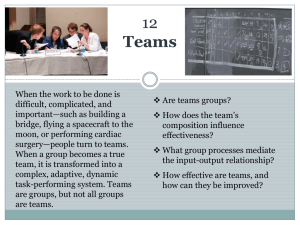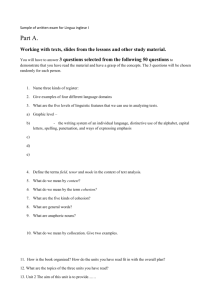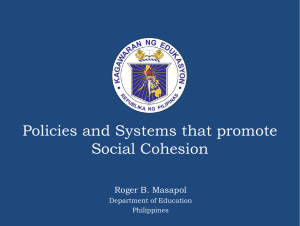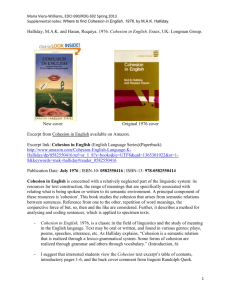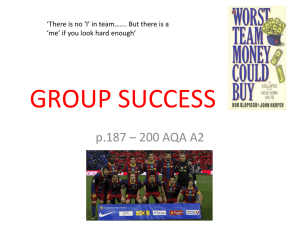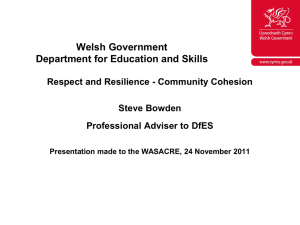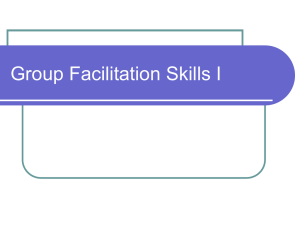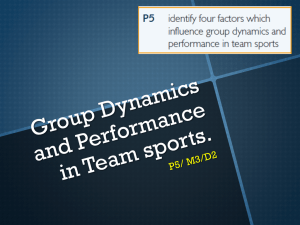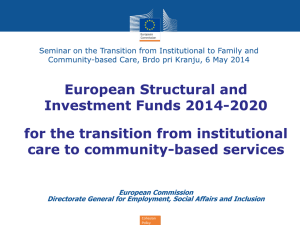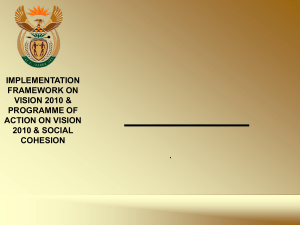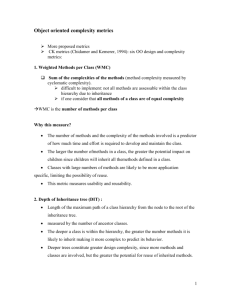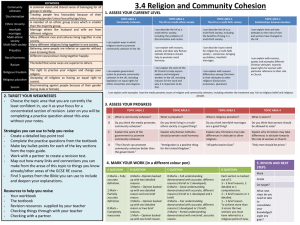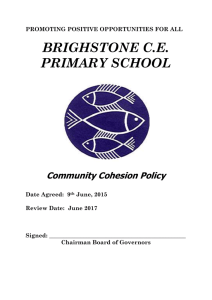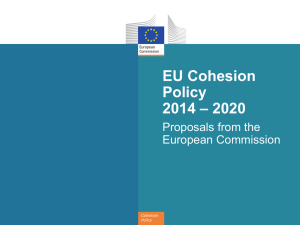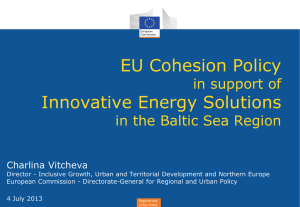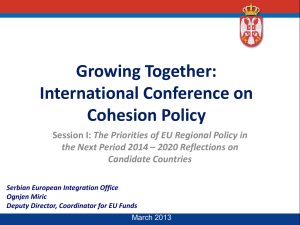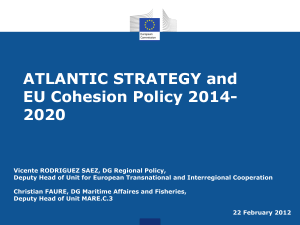Impact of the 2010 World Cup on Social Cohesion, Nation building
advertisement
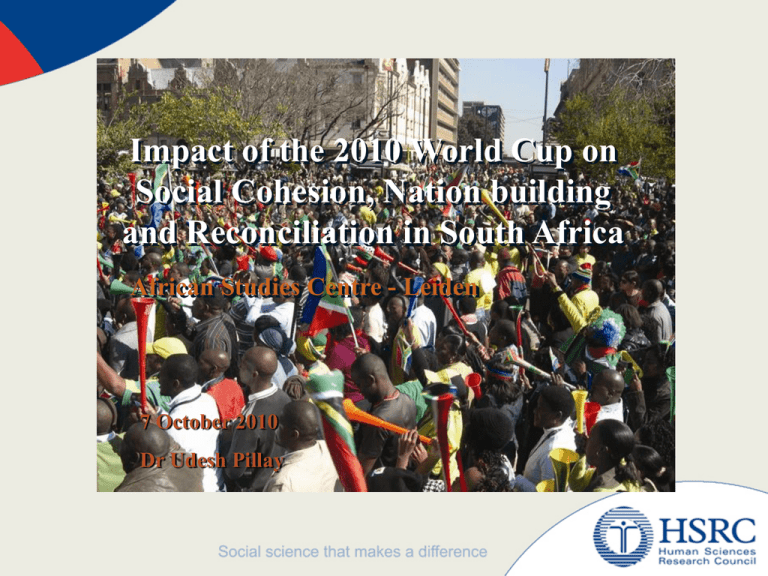
Impact of the 2010 World Cup on Social Cohesion, Nation building and Reconciliation in South Africa African Studies Centre - Leiden 7 October 2010 Dr Udesh Pillay South Africa’s Fifteen Year Review “Social cohesion broadly refers to what gives a society the capacity to co- operate in a way that creates the possibility for positive change. It is vital for effective state action in conditions which might require trade-offs. Across the three terms of government since 1994, the consistent call for unity of all society in practical action for development reflects the importance of social cohesion to democratic government in South Africa…” (Towards a Fifteen Year Review, 2009) President Zuma on the 2010 World Cup From above, President Zuma addressing the country on the opening of the World Cup explained: “The South African flag has become the most popular item on the shopping list of South Africans and this augurs well for nation-building. This explosion of national pride is a priceless benefit of the World Cup tournament. It is clear that millions of our people have waited for years and looked upon this tournament with hope, pride and a sense of belonging. Sport has always played an important role in our historical mission to build a united, non-racial and prosperous South Africa and a better world. Almost all sporting codes in our country such as rugby and cricket have made a contribution to build social cohesion and human solidarity. It is an opportunity for South African to project a contemporary, reinvigorated image of Africa, to celebrate African culture and identity, and to enhance South Africa’s pride and identity” (11 June 2010) Social Cohesion social cohesion is a complex, multi-faceted concept that relates to a broad range of social phenomena. in sport an “intangible” benefit associated with nation-building and intense identity formation, projection and patriotism. provides us with socio-cultural “touchstones”, and seen as enhancing the prospects for, and quality of democratic life. opportunities to build and project common political identities. from these derive “imaging” and “branding” opportunities. Experience / Impressions football in Brazil. 2006 Football World Cup (Germany). inflated status as nation-builder and social unifier? (“ninety minutes of patriotism”). sectoral interests exploit sport to achieve particular outcomes (exclusionary networks). impact on political and economic realities doubtful, limited potential? co-ordinated “legacy” planning is needed. The Disclaimer “ Is it the case that some groups benefit from unity more than others? Does unity have any impact on issues not relating to sport. Ultimately, these mega-sporting events will not impact significantly as the foundation upon which nation-building can be achieved, for example, improvements in the economy, education, communication, health, and other critical aspects of the majority of the country’s people will be negligible”. (Hendricks, 2008) A Framework for Social Cohesion SCI Social Integration in Developing Societies: Maximizing the benefits of mega-sporting events Any conceptualisation must take socio-economic conditions and social factors of the “bid” country into account When conceptualisation is translated into the actual “bid” proposal, the following socio-economic conditions, inter-alia, need to be considered: past, current and projected levels of economic growth/GDP employment/unemployment rates poverty levels income inequality gap (SA Gini Coefficient currently at 0.67) access to basic services levels of crime HIV Aids and infections diseases The bid must also consider the following social cohesion factors: adherence to the role of law constitutional values democratic principles strength of civil society voter participation pride, patriotism sense of national identity state of race relations notions of citizenship The bid proposal must then clearly and unambiguously outline a plan of action (and direct strategies for intervention) for how these socio-economic and social integration objectives can be achieved (including projections through appropriate modeling methodologies) This will require a balance/calibration between the direct objectives of a mega-event and broader societal goals (a social compact is needed to articulate a proper and lasting legacy) Mega-event planners (and other stakeholders) must then anticipate post-event activity that could compromise “tangible” and “intangible” benefits. social and political interest changing economic conditions leadership crises political shifts shifting national priorities overstated benefits Goals must be set realistically and legacy articulated unambiguously or else a mismatch between expectations and reality will prevail. Benefits (National) Benefit for SA of hosting the 2010 FIFA Soccer World Cup 35 Percentage 30 25 Putting SA/city or area on the international map 20 Job creation/ job opportunties 15 Economic growth 10 5 0 2005 2006 2007 Year 2008 Benefits for South Africa (National, Provincial and Host City) 100% CT WC SA 90% 80% 70% Other 60% None 50% Social Benefits Infrastructure Benefits 40% Economic Benefits 30% 20% 10% 0% 2006 2007 2005 2006 2007 2008 2005 2006 2007 2008 Benefits for your city (National, Provincial and Host City) CT WC RSA 100% 90% 80% 70% Other 60% None 50% Social Benefits 40% Infrastructure Benefits 30% Economic Benefits 20% 10% 0% 2006 2007 2005 2006 2007 2008 2005 2006 2007 2008 Benefits for your neighbourhood (National, Provincial and Host City) 100% CT WC SA 90% 80% 70% Other 60% None 50% Social Benefits 40% Infrastructure Benefits Economic Benefits 30% 20% 10% 0% 2006 2007 2005 2006 2007 2008 2005 2006 2007 2008 Benefits for you (National, Provincial and Host City) 100% CT WC SA 90% 80% 70% Other 60% None 50% Social Benefits 40% Infrastructure Benefits 30% Economic Benefits 20% 10% 20 08 20 07 20 06 20 05 20 08 20 07 20 06 20 05 20 07 20 06 0% Conclusion (1) mega-sporting events as a “social unifier” highly questionable (especially in a developing country context). the “social capital” benefits are inevitably overstated. but careful planning and co-ordianted “legacy” plans may help sustain some form of social momentum. “sustainable” benefits beyond the economic need proper discussion and articulation. may exacerbate “haves and have nots” conundrum. Conclusion (2) In South Africa ongoing legacy of apartheid. dynamism of post-apartheid society has paradoxically introduced new challenges: high levels of rural to urban migration burgeoning informal settlements changes in household structure high levels of unemployment increasing levels of poverty income inequality gap is now The World’s highest a divided and fractured society (“rainbow” nation a contrived metaphor) mega sporting events – often an ill-considered idea that impairs and distorts a country’s economic growth path. disastrous if (in a developing world context) mega-sporting events were to become a central component of economic policy. Centre for Service Delivery T: +27 (0) 12 302 2528 F: +27 (0) 12 302 2515 E: upillay@hsrc.ac.za www.hsrc.ac.za


